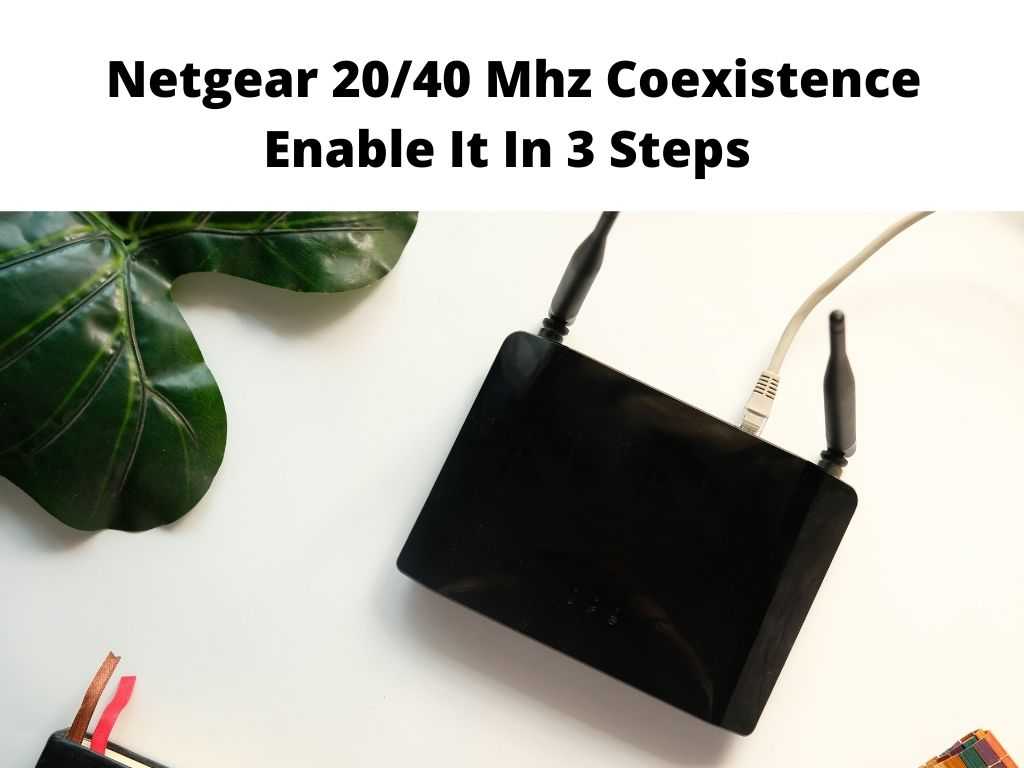
Using the right router is essential when it comes to wireless connections. This is because it’s the role of the router to stream any wireless connections.
Bandwidths specify the range your broadcast is expected to cover. The 20MHz is normal bandwidth while 40MHz is twice that, hence by definition, 40MHz is the maximum that can be used.
Some users are confused about Netgear to enable 20/40 MHz coexistence; it will be addressed in this article.
Table of Contents
20Mhz and 40Mhz coexistence explained
For those using Netgear router, it’s important to understand that 20/40MHz coexistence is likely to be enabled by default.
The essence of these settings is to prevent any form of interference with the wireless connections. In turn, the user will be able to enjoy a perfect wireless internet connection.
But the user still has the choice to either use the feature or disable it which will result in maximum supported wireless connection.
It’s also important to define the internet channels. The 40MHz though it has maximum channels, the hardware which is dated can’t be access this channel.
If you’re still making use of the old router, you need to activate 20/40MHz coexistence to become vital.
By implication, if the feature is not enabled, 40MHz can only be enabled with 2.4Ghz.
On the other hand, with a Good Wi-Fi policy, the channel widths of the Wi-Fi will now be around 20MHz. With this, fewer signal intrusions will be guaranteed.
Another important fact is that 40Mhz and 20Mhz are options from the 2.4Ghz network. The normal bandwidth is 20MHz while the doubled bandwidth is 40Mhz.
Tech experts have recommended that users can actually make use of either 20MHz/40MHz coexistence when using 20MHz channels.
The reason is that if 40MHz is used, there will be overlap in the connection which in turn will return to performance issues.
Importance of enabling 20/40 MHz Coexistence
As stated earlier, Netgear routers are 20/40 MHz enabled by default. The essence is to prevent any form of interference especially from wireless connections nearby.
But as a user, you still have the option to disable the settings to suit you because it helps in accessing the maximum supported internet speed.
But it’s important to realize that obsolete hardware will be unable to use the 2.4GHz devices on 20MHz bandwidth.
But the moment the 20/40 MHz coexistence is enabled, it’s possible to use the bandwidths together.
Enabling 20/40 MHz Coexistence
- For this purpose, first, you’ve to launch your browser, then log into the router.
- Directly on the interface of the router, tap on ‘advanced setup’.
- Click on wireless settings, clear the ‘enable 20/40MHz coexistence,’. Tab on apply.
When this option is disabled, the 2.4GHz can now operate in maximum speed support.
However, the maximum speed can also be reduced when the option is enabled which in turn reduces the internet speed by half.
Disabling 20/40 MHz Coexistence
Doing this will definitely make the 2.4GHz wireless channel maximize its speed. But the challenge is that it will lead to different forms of interference.
By implication, disabling in all ramifications won’t improve your bandwidth rather it will result in unplanned issues.
The decision is still yours to either allow it to be activated or choose to deactivate it.
If you make up your mind to proceed with the latter option, follow the guide below;
- First, launch your preferred browser on your device.
- Type http://www.routerlogin.net in your search bar. From here, you can now access the login page of the router.
- Provide the required credentials to complete the login.
- Tab on advanced settings.
- Direct your cursor to Advanced setup, click on it.
- Click on wireless settings.
- Confirm if the box beside ‘Enable 20/40 MHz coexistence’ is ticked. If is it, tab on it to clear it.
Note: Most users have complained they’re unable to find the settings following the steps indicated above. Hence, it advisable to tab on Advance >>>> Advanced setup >>> Wireless setup. You’ll be able to find the enable or disable feature here. In summary, the 20/40MHz coexistence is put in place to offer a multipurpose and safe internet connection. This is why the feature is already switched on the Netgear router (default). In as much as disabling it will help maximize the internet speed, it will result in overlapping issues. Newer Wi-Fi devices can comfortably use 40Mhz on 2.4Ghz. It’s important to note that 40Mhz is the maximum channel width that is allowed to function on 2.4Ghz. For those that own any legacy device, ensure that 20/40Mhz is left enabled. This will allow any older devices to connect to the Wi-Fi. Disabling this feature is a NO NO!!! especially when any of your devices make use of Bluetooth or needs to use 2.4GHz Wi-Fi most times. What Netgear refers to as ’20/40MHz coexistence’ is perhaps the required respect for the ’40MHz intolerant’ bit which can be found in some client’s sets. On every Netgear router, it’s enabled by default. Doing this implies there will be np interference that will exist in any network. On the other hand, this feature can be disabled if you want to help your devices access maximum support internet speed.In Conclusion
Frequently Asked Questions
Is it necessary to enable 20/40 MHz coexistence in the Netgear router?
Is it advisable to enable or disable 20/40 MHz coexistence?
What is the implication when 20 40 MHz coexistence is enabled?
Was this helpful?


